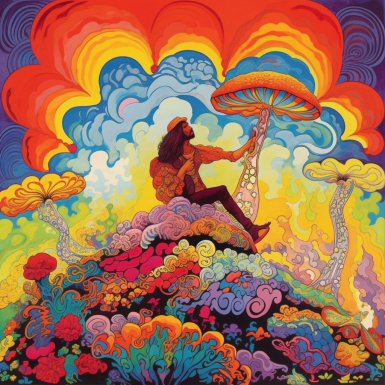
 The Evolution of Psychedelic Rock Lyrics and Themes
The Evolution of Psychedelic Rock Lyrics and Themes
Leave a comment
Psychedelic rock emerged in the mid-1960s as a groundbreaking genre that sought to replicate and enhance the experience of altered consciousness through music. Characterized by its experimental sounds, surreal lyrics, and intricate compositions, it played a crucial role in shaping the counterculture movement of the time. Psychedelic rock lyrics, in particular, not only reflect the socio-political climate of the era but also encapsulate the quest for deeper understanding, transcendence, and self-exploration.
This article explores the evolution of psychedelic rock lyrics and themes, demonstrating how they mirror cultural shifts, musical experimentation, and changing perceptions of consciousness.
Historical Context
To understand the evolution of psychedelic rock lyrics, it is essential to consider the historical context in which this genre was born. The 1960s was a time of immense social upheaval, characterized by the rise of the counterculture movement, which advocated for peace, love, and an alternative lifestyle. Influenced by the Beat Generation and Eastern philosophies, many young people began to seek new ways of thinking and being.
Additionally, the Vietnam War created a backdrop of tension and unrest, prompting musicians to voice their dissent against political injustices. As disillusionment grew, so did the desire for self-exploration and expanded consciousness, fueled by the widespread use of mind-altering substances like LSD and marijuana. This cultural climate laid the foundation for the emergence of psychedelic rock, as artists sought to articulate their experiences and ideologies through music.
Early Psychedelic Rock (1965-1967)
The early years of psychedelic rock (1965-1967) saw the genre begin to take shape, marked by innovative bands and groundbreaking songs. One of the earliest examples is The Byrds’ “Eight Miles High,” which features lyrics that evoke a sense of disorientation and exploration. The song’s use of unconventional time signatures and guitar effects perfectly complements its lyrical content.
Another landmark track is The Beatles’ “Lucy in the Sky with Diamonds,” which captures the essence of psychedelic imagery through dreamlike language and vivid visual descriptions. Lyrics like “cellophane flowers” and “newspaper taxis” paint a surreal landscape, inviting listeners to immerse themselves in a world of imagination.
Jefferson Airplane’s “White Rabbit” further exemplifies early psychedelic themes, blending the concept of the mind’s journey with allusions to Lewis Carroll’s “Alice’s Adventures in Wonderland.” The song’s lyrics reflect a quest for knowledge and self-discovery, making it a quintessential piece of psychedelic rock.
Common themes during this period included exploration of altered states of consciousness, nature, and surreal imagery. Artists drew heavily on their experiences with drugs and sought to communicate these sensations through their lyrics. The incorporation of non-Western instruments and unconventional song structures enhanced the surreal quality of their music, inviting listeners into a new auditory realm.
The Peak of Psychedelic Rock (1967-1970)

The peak of psychedelic rock (1967-1970) marked a period of profound lyrical depth and complexity. As the genre matured, so did its themes. The Doors, for instance, offered existential reflections in songs like “The End,” where frontman Jim Morrison’s haunting lyrics delve into mortality, desire, and the search for meaning. The song’s chilling and provocative lines resonate with the darker aspects of the human psyche, reflecting a shift toward more introspective themes.
Pink Floyd also contributed significantly to this evolution with tracks like “Astronomy Domine,” which explores cosmic and existential themes. The band’s lyrics often questioned the nature of reality and humanity’s place in the universe, offering a broader scope for listeners to contemplate.
During this period, psychedelic rock lyrics began to reflect spiritual and philosophical explorations. Artists like The Grateful Dead infused their songs with elements of spirituality, encouraging listeners to seek enlightenment and connection with the universe. This emphasis on introspection and spiritual awakening marked a departure from earlier, more superficial themes.
The influence of literature and art also became apparent in psychedelic rock lyrics. The allusions to literary works, such as Aldous Huxley’s “The Doors of Perception,” highlighted the interplay between music and literature. Furthermore, the visual art of the era—characterized by vivid colors and intricate designs—found its way into album covers and stage performances, reinforcing the psychedelic experience.
The Decline and Transformation (1970-1980)
As the 1970s unfolded, psychedelic rock began to decline in popularity, giving way to new musical trends like punk and disco. The genre’s once-experimental nature became diluted as mainstream music shifted towards more commercially viable sounds. However, the impact of psychedelic rock on lyrics and themes remained, influencing subsequent genres.
During this period, lyrical content evolved to reflect more personal and introspective themes. Artists began to explore their emotions and experiences in a more intimate manner, often moving away from the surrealism of earlier works. For example, David Bowie’s “Space Oddity” incorporates cosmic imagery while also delving into themes of isolation and existential crisis, showcasing a blend of psychedelic and personal narrative.
The Velvet Underground’s song “Heroin” offers a stark portrayal of addiction and the struggles of urban life. While it retains some psychedelic elements, the lyrics prioritize raw honesty and emotional depth over whimsical imagery, reflecting a shift in the genre’s focus.
Despite the decline of psychedelic rock as a dominant genre, its influence persisted, seeping into various musical styles and shaping the lyrics of artists in the decades that followed. The fusion of psychedelic rock with other genres, including new wave and progressive rock, created a rich tapestry of lyrical themes that continued to resonate with listeners.
The Revival and Resurgence (1980-Present)
The 1980s and 1990s saw a revival of interest in psychedelic rock, particularly with the emergence of neo-psychedelia. Bands like The Flaming Lips and Tame Impala drew inspiration from the classics, infusing their music with contemporary themes while paying homage to the genre’s roots.
Contemporary psychedelic rock lyrics often explore the complexities of modern life, incorporating themes of technology and virtual realities. Tame Impala’s “The Less I Know The Better” exemplifies this evolution, blending dreamy lyrics with a catchy melody while addressing the challenges of relationships in a digital age.
Environmental themes have also gained prominence in modern psychedelic rock, as artists reflect on the pressing issues of climate change and sustainability. This shift reflects a growing awareness of global challenges and a desire to inspire change through music.
Moreover, the fusion of psychedelic rock with electronic music has expanded the genre’s boundaries. Collaborations between psychedelic artists and electronic musicians have resulted in innovative sounds and lyrics that explore the intersection of technology and consciousness. These collaborations demonstrate how the themes of psychedelic rock continue to evolve, adapting to contemporary societal concerns.
Evolution of psychedelic rock lyrics and themes

The evolution of psychedelic rock lyrics and themes is a testament to the genre’s adaptability and cultural relevance. From its origins in the counterculture movement to its revival in the modern music landscape, psychedelic rock has continually reflected the complexities of human experience, consciousness, and societal change.
As we explore the rich tapestry of lyrics that have emerged from this genre, it becomes evident that psychedelic rock is not merely a musical style but a profound expression of the human quest for understanding and connection. Its enduring influence on new generations of artists and listeners ensures that the themes of exploration, spirituality, and introspection remain relevant in today’s ever-changing world. Through its evolution, psychedelic rock continues to inspire, challenge, and expand the horizons of music and consciousness.
Categorised in: Psychedelic



